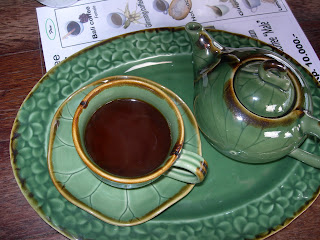I decided that this was a good day for an expedition. The rain had tapered off somewhat and I was itching to get out and about. I wanted to see the closest volcano, Gunung Batur, as well as all the incredible spices that grow at this latitude all around the world: cinnamon, vanilla beans, chocolate, nutmeg and coffee. Ben and Stephanie, who had arrived in the late afternoon on the 27th, decided to join me. Our driver and guide for the expedition was Made, pronounced Mod-day. A leisure concierge at our hotel, he spoke English really well and was, in addition, knowledgeable and open to answering our many questions.
We headed north to the volcano which last erupted in 2000. It is often shrouded in clouds so we considered ourselves fortunate to get such a good view.
Then on to see things growing. Because it was getting late and the plantations were closing for the day, Made took us to an agro-tourism site that had examples of everything I wanted to see.
Cinnamon is the bark of a tree. When the bark is removed, the trees grows it back. The harvested bark curls up to form cinnamon sticks.
Vanilla in its natural form is a long slender green bean, which turns brown as it dries.
Cacao beans from which chocolate is made comes in a pod which changes from green to yellow as it ripens.
Coffee berries or cherries, containing the coffee bean, change from green to red as they ripen. Traditionally the beans are removed from the berries, placed in a ceramic pot and stirred over a fire until they begin to give off the aroma we associate with coffee.
But do you know that the Asian palm civet, a close relative of the cat and mongoose, is instrumental in making the most highly regarded (and expensive) coffee in the world? Well, these little creatures feed on ripe red coffee berries. The berries pass through their digestive system, coming into contact with enzymes which partially digest them. The coffee farmers collect the poop and carefully wash and dry the coffee beans before lightly roasting them. For a full description, check out www.animalcoffee.com/process/php. Prices vary but you can get a pound of this special coffee for between $120 to $350. If you find a really low price, it’s probably not the real thing.
The three of us tried a cup and were amazed by the subtlety and depth of the flavor. I was also amazed by how quickly the caffeine hit me, being primarily a tea drinker and an herbal one at that.
Subscribe to:
Post Comments (Atom)









No comments:
Post a Comment